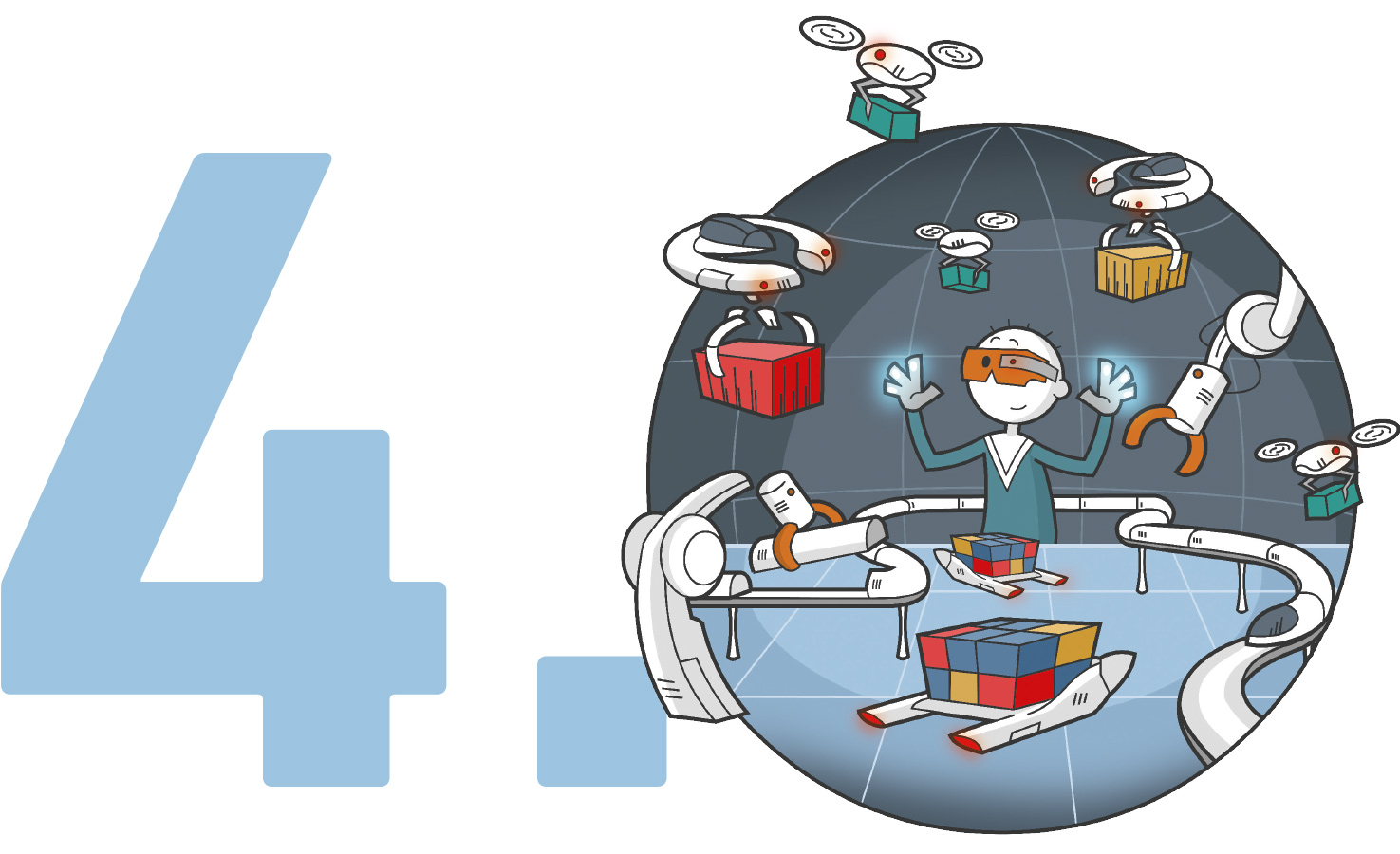(Kopie 1)
Logistics 4.0 – Insight into the cockpit of the future

By Hans-Georg Scheibe, Management Board, and Prof. Dr.-Ing. Werner Bick, Chief Representative, ROI Management Consulting AG
"The world is an aggregate of facts, not things," wrote Ludwig Wittgenstein in 1918. Those who find this type of abstract logic too complex, can take a look at logistics in 2018 instead. They may see some German SUVs outside the factory gates waiting to be shipped. Pretty massive and impressive THINGS ... ... but not FACTS that can be summed up to the world.
The Wall has to Go
The act behind the action, the added value, not only takes place in Munich, Stuttgart, Wolfsburg or Zuffenhausen. It starts somewhere in the ore mines of Asia, in the IT labs of California, or the rubber plantations and leather workshops in Africa. And of course it does not stop at the factory parking lots. Because that’s actually where it really starts, with the added value. Mind you, even Wittgenstein would obviously have been aware that raw materials are not mined inside the factory premises, but delivered to the factory gates. Things get even more exciting when there are no more factory gates. Or no factories altogether. Welcome to Logistics 4.0!
Traditional factories are process circuit breakers - with stone, glass and metal interfaces. Smart factories are part of a holistic, horizontally and vertically integrated value creation process that separate themselves from the rest by eliminating these interfaces - and thus physical and digital boundaries. The consequences of this change are demonstrated in the planning centre of Logistics 4.0.
Things get even more exciting when there are no more factory gates. Or no factories altogether. Welcome to Logistics 4.0!
Suppliers merge with customers
Of course, the absence of factory gates does not mean that suppliers stop delivering goods. Rather it means that the role of suppliers is fundamentally changing. The walls of the traditional factories also mark the boundaries and limitations of ownership and responsibility: The supplier delivers his goods - and is out of the game. In the smart factory these boundaries are drawn virtually - if at all. An example of this are Supplier Managed Inventory concepts (SMI), in which the supplier takes over the management of his inventory in the customer’s warehouse, or even remains the owner of the goods until they are removed for delivery (consignment warehouse).
These methods, some of which have been known for many years, are being significantly expanded in the context of Logistics 4.0: Thus, even processes are conceivable in which the suppliers integrate entire modules in the end products without actively involving the customer in the process at all. The transfer of ownership, payment transactions and even the processing of taxes and duties can be fully automated and flexible, for example, through the use of smart contracts, one of the most promising applications of blockchain technology.
Transfer of ownership and payment transactions can be fully automated through smart contracts.

Logistics from the cloud
The prerequisite for this is the corresponding design of the information flows within the value creation network. The industrial sector has been using electronic data interchange (EDI) for over forty years. However, until a few years ago only very creative spirits would have spoken of an information flow. Expensive IT solutions, missing standards and complicated connections were not the only obstacles. Progress was also obstructed by the fact that the communication consisted of nothing but 1:1 connections that were linked in a very laborious and error-prone way.
This situation changes radically with centralized data management. The adaptation of cloud technology means a real turnaround for logistics. For the first time, information can be merged easily, securely, cheaply and in real-time and processed via common front-ends. The cloud stops the system from growing uncontrollably and pushing data laboriously from bottom to top. It enables real cooperation of all partners in the value chain.
Cloud technology means a real turnaround for logistics. It enables real cooperation of all partners in the supply chain.
Management by Exception
But even this change is only the beginning. Looking a few years into the future, you can envision smart containers, vehicles and warehouses coordinating and controlling autonomously via the cloud and using the cloud as an information resource, just like the employees. They become cyber-physical objects in which the physical and the data world merge. Human intervention and even data input by employees are only necessary in this world if massive deviations from plan and problems endanger the process. The control paradigm of Logistics 4.0 is “Management by Exception”: Unimaginable amounts of communication processes and terabytes of data are generated every day, but we barely even see the surface of it. And finally, the cloud is creating the conditions for disruptive technologies, especially blockchain, to enter logistics.
The Non-Warehouse
The counterpart of information processes in logistics is physical flow. Logistics means movement – storage means standstill. The fact that these two do not go hand in hand, is obvious. Meanwhile, logistics has overshadowed the warehouse. Ideally, with just-in-sequence concepts, a good logistics structure ensures that its flow gets by without a warehouse: direct installation of parts makes inventory unnecessary. The parts demand and delivery time are dictated by the production.
However, if stocks are unavoidable, for example, because production and planning differ and the sequential delivery would be too expensive, it will at least be kept to a minimum. One example is the use of mobile warehouses, i.e. trailers that drive parts directly to the next stations, so that the amount of interfacing is minimized. Another example is the autostore concept, in which a warehouse is physically compressed to a maximum: It resembles a highly structured Rubik’s Cube, on whose surface self-driving vehicles are positioned that can accept and deliver goods.
Logistics means movement – storage means standstill.

Ants against the central office
The integration of value creation networks also requires new control mechanisms. Because the absence of “process circuit breakers” and buffers also causes risks and shocks to propagate throughout the entire chain. In order to achieve high stability and flexibility of processes, Logistics 4.0 relies on the decentralization of these processes. This makes strong ERP systems and central control stations largely superfluous: Machines and transport systems increasingly communicate with each other independently and notify about material demands at an early stage. They compete for contracts with the automatic agent system, which distributes the tasks according to a predefined list of criteria. Realistically though, even this automatic “dispatch centre” is no longer needed. Like an ant colony, collective intelligence systems will decide within the collective who can do the job best.
Presumably, this revolution will also be distinguished by doing more than merely creating new solutions, new forms of value creation and rationalization. The digital transformation in logistics will also bring with it new forms of challenges and problems whose scope we still can not assess today. These in turn will require their own solutions. Therefore, I’m curious to see how long it will take for us at ROI DIALOG to offer you an article about Logistics 5.0.
Powerful ERP systems and central control centres are superfluous in Logistics 4.0.
